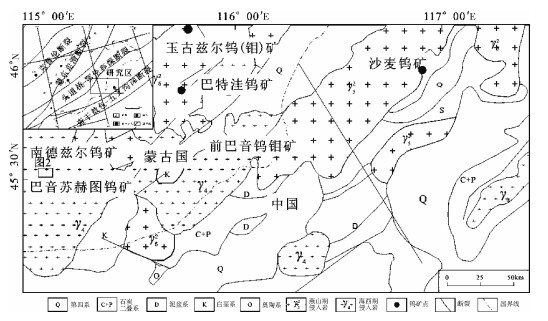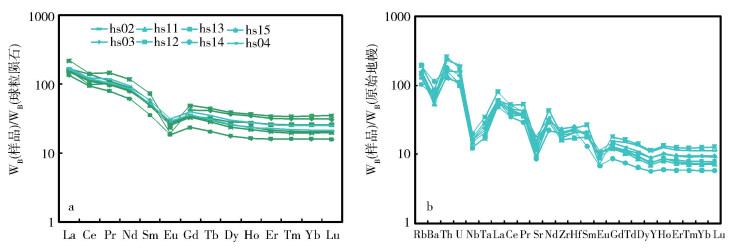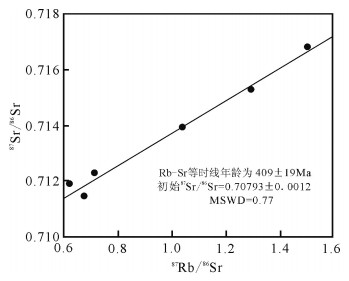Geochemical characteristics of dacite from the Bayinsuhetu deposit in South Mongolia and its tectonic implications
-
摘要:
在南蒙古巴音苏赫图矿区古生代地层中新发现一套火山岩,其Rb-Sr同位素年龄为409±19Ma,与前人划分的地层年代(志留纪-泥盆纪)较吻合。英安岩的SiO2含量为63.23%~73.36%,Al2O3含量为10.25%~15.56%。英安岩轻稀土元素富集,重稀土元素亏损,具有较强的负Eu异常。岩石学和地球化学综合研究表明,该套火山岩基本同期同源演化,且岩性变化较小,以流纹岩-英安岩类为主。根据钾含量,该套火山岩为中钾钙碱性系列。英安岩落在靠近盆岭构造域的位置,显示出略亏损的特征,与原始地幔PM端元接近。推测该套火山岩形成于古亚洲洋闭合过程中的岛弧环境,表明火山岩形成时古亚洲洋可能还没有闭合。
Abstract:A set of volcanic rocks were recently found in Palaeozoic strata in the Bayinsukhtuore district of South Mongolia. The RbSr isotopic age of the rocks is 409±19Ma, which is consistent with the chronological age (Silurian-Devonian) obtained from previous work. The SiO2 content of dacite is 63.23%~73.36%, while the Al2O3 content is 10.25%~15.56%. The dacite is LREE enrichment, HREE loss, and has strong Eu negative anomaly. Based on petrology and geochemistry, it is held that this set of volcanic rocks evolved in the same period and came from the same source. The lithologic character of the rocks is mainly of dellenite-dacite type, with little change. According to the Kalium analysis, the volcanic rocks were derived from the potassium calc-alkaline series. It is suggested that the melted mantle source area was reformed by the subducting plate. During this process the original magma was generated from the liquid mantle of the subducting zone. At the same time crustal contamination happened. The magmatic evolution would be the main reason for generating the combined set of the volcanic rocks. It also implies that this set of volcanic rocks was formed in the island arc during the closing of pal-Asia, which indicates that the closing of pal-Asia was later than the formation of this set of volcanic rocks.
-
Key words:
- South Mongolia /
- volcanic rock /
- geochemical characteristics /
- mantle /
- origin
-

-
图 1 中蒙边境钨-钼矿化集中区区域地质简图(据参考文献[31]修改)
Figure 1.
图 7 Y-Sr/Y关系图解[37]
Figure 7.
图 9 研究区火山岩Isr-εNd(t)判别图(底图据参考文献[17])
Figure 9.
表 1 研究区火山岩主量、微量和稀土元素分析结果
Table 1. The analyzed data of major, trace and rare earth elements of volcanic rocks in the study area
样品 HS02 HS03 HS04 HS11 HS12 HS13 HS14 HS15 SiO2 71.39 69.41 67.83 69.32 69.63 72.97 73.36 63.23 TiO2 0.43 0.54 0.58 0.54 0.47 0.48 0.33 0.53 Al2O3 14.47 13.56 14 12.85 15.56 12.63 10.25 12.94 A/CNK 1.35 1.18 1.5 1.09 1.65 1.49 0.94 1.52 A/NK 1.53 1.83 1.88 1.82 1.95 1.91 1.45 1.85 MnO 0.03 0.05 0.04 0.06 0.03 0.04 0.04 0.05 MgO 1.39 1.72 1.97 2.2 1.69 1.8 1.22 1.91 CaO 0.67 2.23 1.04 2.59 0.81 1.02 2.13 0.82 Na2O 4.56 3.05 2.96 3.14 2.9 2.57 2.33 3.3 K2O 1.82 2.2 2.4 1.75 2.97 2.2 2.99 1.46 Na2O+K2O 6.38 5.25 5.36 4.89 5.87 4.77 5.32 4.76 P2O5 0.13 0.22 0.23 0.2 0.14 0.2 0.12 0.21 烧失量 1.9 3.56 2.82 3.96 2.96 2.58 2.86 0.76 合计 99.99 100 100 100 100 100 100 100.01 Ba 418 424.78 400.54 313.54 613.7 389.84 616.79 372.47 Cr 42.41 60.02 63.69 64.15 41.89 47.67 26.68 62.15 Ni 18.52 15.45 20.81 29.47 18.37 19.43 10.44 23.39 Sr 358.02 172.12 236.2 271.6 348.43 241.36 139.79 260.96 V 49.25 58.62 69.42 65.65 48.37 60.54 39.4 69.67 Zr 180.59 203.91 207.43 152 211.53 155.09 180.69 184.73 TFe2O3 3.2 3.94 4.28 4.31 3.51 3.91 2.59 4.11 Ga 16.68 16.9 16.09 15.35 20.17 14.37 14.03 17.8 Rb* 75.09 89.44 99.98 80.53 116.27 89.61 117.44 61.51 Sr 356.36 184.82 220.06 308.6 303.38 240.04 171.03 275.75 Y 47.26 38.31 38.37 30.27 49.28 32.4 24.44 32.94 Zr 180.24 244.92 197.59 170.66 201.97 169.89 210.03 221.7 Nb 11.33 10.7 10.53 9.91 13 8.1 8.18 10.47 Cs 5.98 6.35 9.82 5.16 6.89 6.68 3.36 4.86 Ba* 431.13 483.26 422.32 358.66 561.68 403.22 752.71 461.75 La 39.42 37.43 41.19 37.45 52.03 36.32 31.96 38.86 Ce 86.33 60.06 75.73 70.49 87.18 67.72 58.45 74.2 Pr 10.34 9.51 11.06 9.2 13.54 9.09 7.41 9.64 Nd 41.17 37.99 43.32 37 53.71 36.57 27.99 39.17 Sm 8.69 7.56 8.64 7.24 10.86 7.32 5.29 7.75 Eu 1.08 1.52 1.76 1.41 1.33 1.58 1.05 1.62 Gd 8.45 6.96 7.99 6.58 9.76 6.82 4.72 7.15 Tb 1.49 1.15 1.27 1.03 1.61 1.09 0.74 1.12 Dy 9.06 7.03 7.43 5.84 9.56 6.28 4.35 6.44 Ho 1.89 1.51 1.53 1.2 2 1.3 0.89 1.28 Er 5.1 4.18 4.16 3.25 5.51 3.44 2.57 3.63 Tm 0.77 0.64 0.62 0.49 0.84 0.51 0.4 0.54 Yb 5.03 4.19 4.08 3.17 5.57 3.27 2.58 3.49 Lu 0.77 0.64 0.62 0.49 0.86 0.51 0.39 0.53 Hf 5.82 7.14 5.86 4.88 6.74 4.9 6.22 6.56 Ta* 1.11 0.88 0.83 0.75 1.29 0.63 0.65 1.03 Tl* 0.51 0.58 0.7 0.48 0.7 0.51 0.68 0.38 Pb 19.08 29.49 18.45 14.33 18.18 23.95 18.23 17.94 Bi* 0.35 0.22 0.15 0.29 0.46 0.19 0.1 0.21 Th 18.43 14.42 12.97 11.13 20.65 10.14 13.03 12.67 U 3.98 2.83 3.2 2.04 3.55 2.23 2.11 2.2 LREE 187.04 154.06 181.69 162.78 218.65 158.6 132.15 171.24 HREE 32.55 26.31 27.69 22.05 35.71 23.22 16.65 24.19 ∑REE 219.59 180.37 209.38 184.83 254.36 181.82 148.79 195.42 LREE/HREE 5.75 5.85 6.56 7.38 6.12 6.83 7.94 7.08 注:主量与微量元素在中国科学院地质与地球物理研究所分别采用ICP-AES和ICP-MS分析;球粒陨石标准化值据参考文献[35];主量元素含量单位为%,微量和稀土元素为10-6 表 2 研究区火山岩Sr-Nd同位素分析结果
Table 2. Sr and Nd isotope composition of volcanic rocks in study area
样号 HS02 HS03 HS04 HS11 HS13 HS15 Rb/10-6 85.28 90.04 110.1 69.31 87.67 59.3 Sr/10-6 364 173.3 246.1 278.9 243.8 275.8 87Rb/86Sr 0.6783 1.506 1.296 0.7196 1.041 0.6226 87Sr/86Sr(2σ) 0.711279±15 0.716905±11 0.715226±14 0.712401±14 0.713748±9 0.711880±12 Sm(10-6) 7.654 6.898 8.177 6.425 7.105 7.151 Nd(10-6) 34.09 32.7 38.75 31.44 33.69 33.91 147Sm/144Nd 0.1359 0.1277 0.1277 0.1237 0.1277 0.1277 143Nd/144Nd(2σ) 0.512362±6 0.512323±7 0.512334±13 0.512332±8 0.512338±7 0.512329±6 TDM 1545 1467 1448 1386 1439 1454 Isr 0.707329 0.708135 0.707678 0.708209 0.707682 0.708254 εSr(t) 47.02 58.48 51.99 59.53 52.04 60.16 εNd(t) -2.2 -2.5 -2.3 -2.2 -2.2 -2.4 fSm/Nd -0.31 -0.35 -0.35 -0.37 -0.35 -0.35 T2DM 1333 1360 1343 1328 1335 1349 注:2σ为测量误差(10-6)。研究区火山岩(87Sr /86Sr)i和εNd(t)由409Ma推算;所用参数143Nd /144Nd(CHUR)0= 0.512638,147Sm /144Nd(CHUR)0= 0.1967,λRb87= 1.42×10-12a-1,λSm147= 6.57×10-12a-1 -
[1] Dobrelsov N L, Berzin N A, Buslov M M. Opening and tectonic evolution of the Paleo-Asian Ocean. International[J]. Geo. Rev., 1995, 37:335-360. doi: 10.1080/00206819509465407
[2] Yin A, Mark H. A Phanerozoic palinspastic reconstruction of China and its neighboring regions[C]//Yin A, Mark Harrison. The tectonic evolution of Asia. Cambridge University Press, 1996: 422-485.
[3] 董树文, 吴锡浩, 吴珍汉, 等.论东亚大陆的构造壳变——燕山运动的全球意义[J].地质论评, 2000, 46(1):8-13. http://kns.cnki.net/KCMS/detail/detail.aspx?filename=dzlp200001001&dbname=CJFD&dbcode=CJFQ
[4] 张招崇, 王永强.冀北印支期碱性岩浆活动及其地球动力学意义[J].矿物岩石地球化学通报, 1997, 16(4):6-9. http://kns.cnki.net/KCMS/detail/detail.aspx?filename=kydh704.001&dbname=CJFD&dbcode=CJFQ
[5] 张理刚.东亚岩石圈块体地质——上地幔、基底和花岗岩同位素地球化学及其动力学[M].北京:科学出版社, 1995:1-249.
[6] 陈义贤, 陈文寄.辽西及邻区中生代火山岩——年代学地球化学和构造背景[M].北京:地震出版社, 1995:1-279.
[7] 许保良, 王式洸, 韩宝福, 等.富集型与亏损型A型花岗岩——以燕山地区和乌伦古河地区岩石为例[J].北京大学学报(自然科学版), 1998, 34(2/3):352-362. http://kns.cnki.net/KCMS/detail/detail.aspx?filename=bjdz8z1.028&dbname=CJFD&dbcode=CJFQ
[8] 李伍平, 路凤香, 孙善平, 等.北京西山东岭台组(J3d)火山岩的成因及其构造环境探讨[J].岩石学报, 2000, 16(3):345-352. http://kns.cnki.net/KCMS/detail/detail.aspx?filename=ysxb200003004&dbname=CJFD&dbcode=CJFQ
[9] 李伍平, 路凤香, 李献华, 等.北京西山髫髻山组火山岩的地球化学特征与岩浆起源[J].岩石矿物学杂志, 2001, 2:123-133. http://kns.cnki.net/KCMS/detail/detail.aspx?filename=yskw200102002&dbname=CJFD&dbcode=CJFQ
[10] 李伍平, 路凤香, 李献华, 等.辽西地区义县组火山岩的起源及壳幔相互作用[J].矿物岩石, 2001, 21(4):1-6. http://kns.cnki.net/KCMS/detail/detail.aspx?filename=kwys200104000&dbname=CJFD&dbcode=CJFQ
[11] 李伍平, 李献华, 路凤香.辽西中侏罗世高Sr低Y型火山岩的成因及其地质意义[J].岩石学报, 2001, 17(4):523-532. http://kns.cnki.net/KCMS/detail/detail.aspx?filename=ysxb200104002&dbname=CJFD&dbcode=CJFQ
[12] 李伍平, 路凤香, 李献华.北京西山髫髻组粗安岩的成因及其地质意义[J].岩石矿物学杂志, 2001, 20(3):247-254. http://www.oalib.com/paper/4337617
[13] 李伍平, 李献华, 路凤香, 等.辽西早白垩世义县组火山岩的地质特征及其构造背景[J].岩石学报, 2002, 2:193-204. http://kns.cnki.net/KCMS/detail/detail.aspx?filename=ysxb200202006&dbname=CJFD&dbcode=CJFQ
[14] 李伍平, 李献华.燕山造山带中段中晚侏罗世中酸性火山岩的成因及其意义[J].岩石学报, 2004, 3:501-510. http://kns.cnki.net/KCMS/detail/detail.aspx?filename=ysxb200403014&dbname=CJFD&dbcode=CJFQ
[15] 张旗, 王焰, 王元龙.燕山期中国东部高原下地壳组成初探:埃达克质岩Sr、Nd同位素制约[J].岩石学报, 2001, 17(4):505-513. http://kns.cnki.net/KCMS/detail/detail.aspx?filename=ysxb200104000&dbname=CJFD&dbcode=CJFQ
[16] 韩宝福, 何国琦, 王式洸.后碰撞幔源岩浆活动、底垫作用及准噶尔盆地基底的性质[J].中国科学(D辑), 1999, 1:16-21. http://kns.cnki.net/KCMS/detail/detail.aspx?filename=jdxk199901002&dbname=CJFD&dbcode=CJFQ
[17] 洪大卫, 王式洸, 谢锡林, 等.兴蒙造山带正ε(Nd, t)值花岗岩的成因和大陆地壳生长[J].地学前缘, 2000, 7(2):441-456. http://kns.cnki.net/KCMS/detail/detail.aspx?filename=dxqy200002016&dbname=CJFD&dbcode=CJFQ
[18] 阎国翰, 牟保磊, 许保良, 等.燕辽-阴山三叠纪碱性侵入岩年代学和Sr, Nd, Pb同位素特征及意义[J].中国科学(D辑), 2000, 30(4):380-387. http://kns.cnki.net/KCMS/detail/detail.aspx?filename=jdxk200004005&dbname=CJFD&dbcode=CJFQ
[19] Jahn B M, Wu F Y, Capdevila R, et al. Higly evolved juvenile granites with tetrad REE patterns:the Woduhe and Baerzhe granites from the Great Xing'an Mountains in NE China[J]. Lithos, 2001, 59(4):171-198. doi: 10.1016/S0024-4937(01)00066-4
[20] Wu F Y, Sun D Y, Li H, et al. A-type granites in northeastern China:age and geochemical constraints on their petrogenesis[J]. Chemical Geology, 2002, 187(1/2):143-173. http://www.sciencedirect.com/science/article/pii/S0009254102000189
[21] 郭锋, 范蔚茗, 李超文, 等.早古生代古亚洲洋俯冲作用:来自内蒙古大石寨玄武岩的年代学与地球化学证据[J].中国科学(D辑), 2009, 5:569-579. http://kns.cnki.net/KCMS/detail/detail.aspx?filename=jdxk200905004&dbname=CJFD&dbcode=CJFQ
[22] 刘建峰. 内蒙古林西-东乌旗地区晚古生代岩浆作用及其对区域构造演化的制约[D]. 吉林大学, 2009.
http://cdmd.cnki.com.cn/Article/CDMD-10183-2009093598.htm [23] Blight J H S, Petterson M G, Crowley Q G, et al. The Oyut Ulaan Volcanic Group:stratigraphy, magmatic evolution and timing of Carboniferous arc development in SE Mongolia[J]. Journal of the Geological Society, 2010, 167(3):491-509. doi: 10.1144/0016-76492009-094
[24] Badarch G, Cunningham W D, Windley B F. A New Terrane Subdivision for Mongolia; Impications for the Phanerozoic Crustal Growth of Central Asia[J]. Journa of Asian Earth Sciences, 2002, 21:87-110. doi: 10.1016/S1367-9120(02)00017-2
[25] Ren X D, Kiosses W B, Alexander S M. Regulation of the small GTP-binding protein Rho by cell adhesion and the cytoskeleton[J]. The EMBO Journal, 1999, 18:578-585. doi: 10.1093/emboj/18.3.578
[26] Zeng Q, Liu J, Zhang Z, et al. Geology and geochronology of the Xilamulun molybdenum metallogenic belt in eastern Inner Mongolia, China[J]. International Journal of Earth Sciences, 2011, 100:1791-1809. doi: 10.1007/s00531-010-0617-z
[27] 林强, 葛文春, 曹林, 等.大兴安岭中生代双峰式火山岩的地球化学特征[J].地球化学, 2003, 32(3):208-222. http://kns.cnki.net/KCMS/detail/detail.aspx?filename=dqhx200303001&dbname=CJFD&dbcode=CJFQ
[28] 聂凤军, 张万益, 杜安道, 等.内蒙古朝不楞矽卡岩型铁多金属矿床辉钼矿铼-锇同位素年龄及地质意义[J].地球学报, 2007, 28:315-323. http://kns.cnki.net/KCMS/detail/detail.aspx?filename=dqxb200704000&dbname=CJFD&dbcode=CJFQ
[29] 张德全.大兴安岭南段不同构造环境中的两类花岗岩[J].岩石矿物学杂志, 1993, 1:1-11. http://kns.cnki.net/KCMS/detail/detail.aspx?filename=yskw199301000&dbname=CJFD&dbcode=CJFQ
[30] 周建波, 张兴洲, 马志红, 等.中国东北地区的构造格局与盆地演化[J].石油与天然气地质, 2009, 30:530-538. http://kns.cnki.net/KCMS/detail/detail.aspx?filename=syyt200905002&dbname=CJFD&dbcode=CJFQ
[31] 聂凤军.中蒙边境中东段金属矿床成矿规律和找矿方向[M].北京:地质出版社, 2007.
[32] Chen F K, Hegner E, Todt W. Zircon Ages, Nd Isotopic and Chemical Compositions of Orthogneisses from the Black Forest, Germany:Evidence for a Cambrian Mag-matic Arc[J]. International Journal of Earth Sciences, 2000, 88(4):791-802. doi: 10.1007/s005310050306
[33] Gao S, Rudnick R L, Yuan H L, et al. Recycling Lower Continental Crust in the North China Craton[J]. Nature, 2004, 432:892-897. doi: 10.1038/nature03162
[34] Chen F K, Siebel W, Satir M, et al. Geochronoloy of the Karadere Basement (NW Turkey) and Implications for the Geological Evolution of the Istanbul Zone[J].International Journal of Earth Sciences, 2002, 91:469-481. doi: 10.1007/s00531-001-0239-6
[35] Boynton, Rose W, Dunn, et al. Manual of Ambulatory PEDIATRICS[J]. Ajn American Journal of Nursing, 1984, 84(12):1486. https://www.libreriauniverso.it/articolo/41387/0781788749/Boynton-Manual-of-Ambulatory-Pediatrics
[36] Sun S S, McDonough W S, Chemical and isotopic systematics of oceanic basalts:implications for mantle composition and processes[J]. Geological Society, London, Special Publications, 1989, 42(1):313-345. doi: 10.1144/GSL.SP.1989.042.01.19
[37] Drummond M S, Defant M J. A model for Trondhjemite-Tonalite-Dacite Genesis and crustal growth via slab melting:Archean to modern comparisons[J]. Journal of Geophysical Research Solid Earth, 1990, 95(B13):21503-21521. doi: 10.1029/JB095iB13p21503
[38] 吴华英, 张连昌, 周新华, 等.大兴安岭中段晚中生代安山岩年代学和地球化学特征及成因分析[J].岩石学报, 2008, 6:1339-1352. http://kns.cnki.net/KCMS/detail/detail.aspx?filename=ysxb200806018&dbname=CJFD&dbcode=CJFQ
[39] Manya S, Makenya A H M, Nakamurab E. The geochemistry of High-Mg andesite and associated adakitic rocks in the musoma-mara greenstone belt, northern tanzania:possible evidence for neoarchaean ridge subduction[J]. Precambrian Research, 2007, 159:241-259. doi: 10.1016/j.precamres.2007.07.002
[40] Shinio R. Geochemistry of High-Mg andesite and the tectonic evidence of the okinawa trough-ryukyu arc system[J]. Chemical Geology, 1999, 157:69-88. doi: 10.1016/S0009-2541(98)00199-5
[41] Sorokin A A, Sorokin A P, Ponomarchuk V A, et al. The Age and Geochemistry of Volcanic Rocks on the Eastern Flank of the Umlekan-Ogodzha Volcanoplutonic Belt (Amur Region)[J]. Russian Geology and Geophysics, 2010, 51:369-379. doi: 10.1016/j.rgg.2010.03.004
[42] 邵济安, 路凤香, 李伍平.辽西中生代陆内底侵作用背景下形成的安山岩[J].岩石学报, 2007, 23(4):701-708. http://kns.cnki.net/KCMS/detail/detail.aspx?filename=ysxb200704003&dbname=CJFD&dbcode=CJFQ
[43] 路凤香, 桑隆康.岩石学[M].北京:地质出版社, 2002:15-26.
[44] 李承东, 张福勤, 苗来成, 等.吉林色洛河晚二叠世高镁安山岩SHRIMP锆石年代学及其地球化学特征[J].岩石学报, 2007, 23(4):767-776. http://kns.cnki.net/KCMS/detail/detail.aspx?filename=ysxb200704009&dbname=CJFD&dbcode=CJFQ
-




 下载:
下载:







